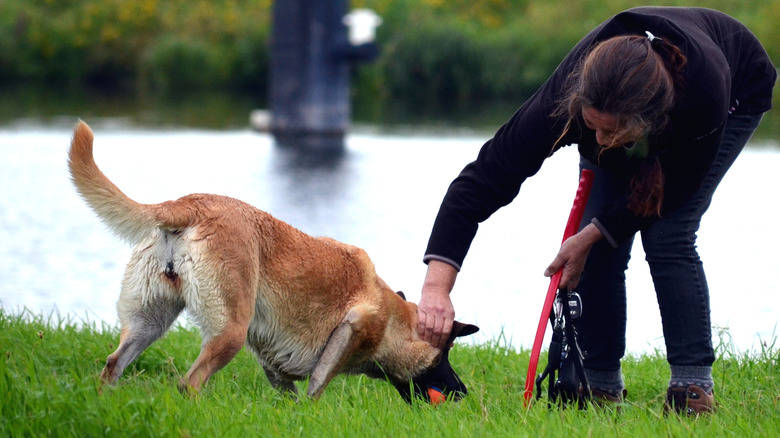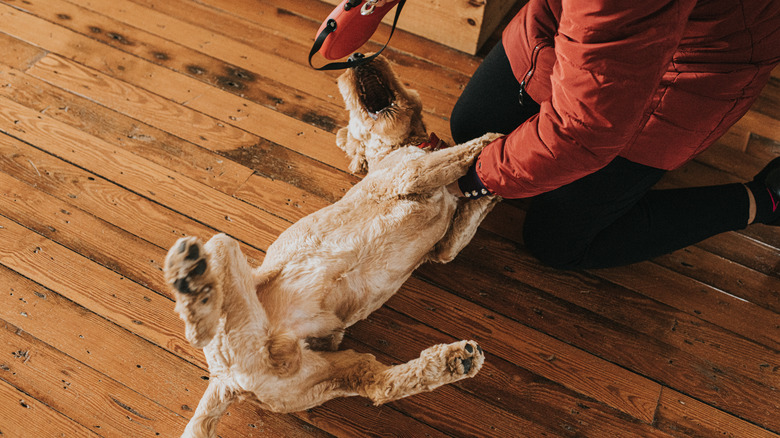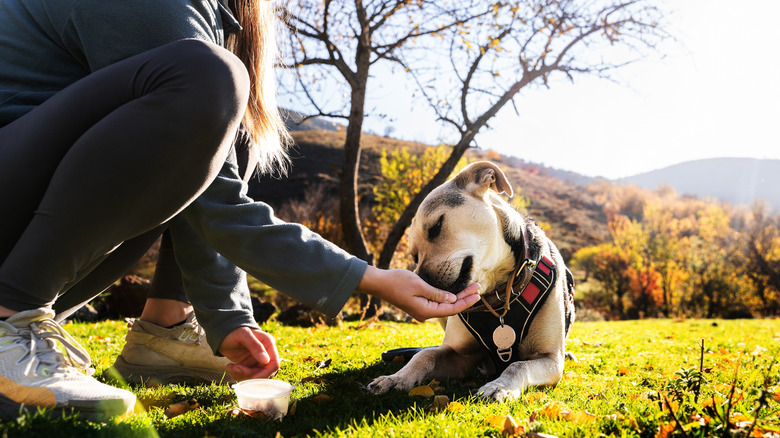11 Things Cesar Millan Gets Wrong About Dog Training, According To Experts
We may receive a commission on purchases made from links.
Self-taught dog trainer Cesar Millan gained worldwide recognition through his television series "Dog Whisperer with Cesar Millan," which aired from 2004 to 2016. He would continue to be a presence on TV with shows like "Cesar 911" and "Better Human Better Dog." Millan also went on to pen several books on dog training, found the Dog Psychology Center in Los Angeles County, and launch a line of dog products and educational videos. The Dog Whisperer also established the Cesar Millan Foundation, which provides training for and helps rehabilitate dogs.
Millan's desire to impact the lives of canines is apparent. Yet his methodologies throughout his career have been questioned by many experts, including other dog trainers and veterinarians. Millan has also been involved in several legal cases, including a 2006 case where a TV producer of "8 Simple Rules" claimed that their Labrador retriever was injured at Millan's training facility after being suffocated by a choke collar and forced to run on a treadmill.
More famously, Junior, Milan's pitbull, was involved in a case in which gymnast Lidia Matis claimed that the dog attacked her at one of Millan's facilities. Junior featured in a second allegation that claimed the canine killed Queen Latifah's dog. Scrutiny such as this outside the show and his history of using controversial techniques has led many to insist that Millan's methods are wrong and often negligent. In fact, several of his core tenets have been identified as dog behavior myths by certified trainers.
1. Flawed dominance theory
Most of Cesar Millan's methods rely on dominance and stepping into the role of the alpha dog. In his book "Cesar's Way: The Natural, Everyday Guide to Understanding and Correcting Common Dog Problems" the dog whisperer echoes this methodology, stating, "If you give only 80 percent leadership, your dog will give you 80 percent following. And the other 20 percent of the time he will run the show. If you give your dog any opportunity for him to lead you, he will take it." The TV series also consistently shows this play for dominance to curve behaviors, yet the broader community has not fully embraced these methods.
The RSPCA (Royal Society for the Prevention of Cruelty to Animals), the oldest charity for animal welfare (established in 1824), addressed the outdated dominance theory through its Australian branch, writing, "The 'dominance' model for dog behaviour poses serious dog welfare problems. Dominance models may use aversive training techniques such as 'alpha rolls', staring the dog down or other confrontational methods and punishment which can cause fear, pain and distress to dogs. In addition, these methods generally do not address the underlying cause of the unwanted behaviour which is why they are often unsuccessful. In fact, dominance training methods are not scientifically proven to be effective."
2. Misunderstanding the evolution of dogs
Cesar Millan's purportedly flawed dominance theory appears to come from a misunderstanding of the very nature of dogs themselves. The Dog Whisperer sticks to the idea that canines are not far removed from their ancient ancestors and that their pack mentality is still at the forefront. In "Cesar's Way," Millan wrote, "Wolves are disciplined not only when they hunt but also when they travel, when they play, and when they eat. Nature doesn't view discipline as a negative thing. Discipline is DNA. Discipline is survival."
Author of "How the Dog Became the Dog: From Wolves to Our Best Friends," "Dog's Best Friend," and "A Dog's History of America" Mark Derr spoke out against this concept in a 2006 op-ed for The New York Times and more recently in Psychology Today in 2012. In the latter piece, Derr highlighted the research done by naturalist L. David Mech, who observed in his studies that "dominance contests with other wolves are rare, if they exist at all," pointing to a faulty premise that dogs need dominance to learn.
Moreover, The Wolf Education & Research Center highlights several differences between how dogs and wolves interact with people. Dogs and wolves problem-solve differently, with pets dependent on their owners to learn, while wolves use trial and error. Dogs and humans are also unique in how positive interactions between the two release oxytocin and strengthen bonding. These differences suggest a flawed methodology in looking at wolves to train dogs.
3. Overstimulating dogs with fear
On his various shows, Cesar Millan uses 'flooding,' a controversial technique that involves overexposing a dog to the stimulus that causes them to behave in an undesired way. An example of Millan utilizing this technique appears in "Cesar 911" Season 4, Episode 11, titled "Izzy in a Tizzy." In the episode, Izzy, a black lab, becomes aggressive towards anyone entering her space. As part of treatment, Millan gets his cameraperson, a stranger to the aggressive canine, to enter Izzy's space and not remove himself until the dog's aggression subsides.
In a statement issued by the IAABC (International Association of Animal Behavior Consultants), the organization spoke out against the practice and discussed its repercussions: "When flooding is used in animal behavior change and training, the learner is not given the choice to engage with the stimulus or stimuli ... Such interventions can cause significant trauma to the animal learner. These methods are accompanied by significant risks not only to the behavioral welfare but also to the physical health of animals subjected to flooding and extreme distress." Based on this, owners looking for a qualified dog trainer should avoid those using aggressive techniques like flooding.
Hanne Grice Dip, clinical animal behaviorist, training Instructor, author, and founder of Hanne Grice Pet Training & Behavior, wrote about the adverse effects of flooding on her website. She stated that it can reinforce negative associations and create a lack of trust in your pet and other issues. Grice explained, "Flooding can result in a traumatic experience for dogs. Being overwhelmed by a fear-inducing stimulus without any opportunity to escape or seek comfort can lead to extreme distress, anxiety, and potentially long-lasting psychological harm."
4. Invading a dog's safe space
The episode "Izzy in a Tizzy" highlights Millan's use of flooding while also showing another common tactic employed by the Dog Whisperer: purposely encroaching on the canine's only safe space in the home, cornering the frightful pooch, and not allowing them to escape. Creating a safe space is fundamental for introducing a dog to a new home, and it is essential to let them have that area for themselves. Invading a space with a stranger and evoking fear can also lead to someone getting bitten.
On the site Dogkind, trainers and educated behaviorists Kelly Lee and Rachelle Gagnon explain why a safe space is vital to a dog's happiness and development: "When your fearful dog doesn't have to worry about getting their basic needs met, or hiding from people or other pets, they become more motivated to explore and interact with their environment in positive ways." Cathy Madson, MA, FDM, CBCC-KA, CPDT-KA, writing for Preventive Vet, adds, "By giving your dog the choice to leave a situation, you increase their confidence in dealing with uncertain or stressful situations." Madson also highlights how having a safe space can lead to safe play with young family members: "This can help prevent unfortunate bite incidents between the family dog and children."
5. Ignoring body language
In Season 2, Episode 4 ("JonBee, Violet & Hudson, and Buford") of the "Dog Whisperer," Cesar Millan faces several aggressive canines, including a Jindo named JonBee. During the segment, Cesar continually approaches the dog despite its aggressive attitude and constant attempts to escape. Yet, experts have spoken about the importance of understanding canine body language and acting accordingly.
Professional dog trainer and the author of "What the Dogs Taught Me about Being a Parent" Dan Abdelnoor outlines the more commonly accepted method of dealing with an overly aggressive dog on his site, The Online Dog Trainer. He highlights several points counter to the Cesar Millan method, including: "If your dog shows signs of fear, give them space and remove them from the situation. Never force interaction." He also talks about the importance of realizing early warning signs so they don't spiral, writing, "Recognize subtle signs like yawning, lip licking, whale eye (showing the whites of their eyes), pacing, panting, tail tucking, or shaking. These indicate your dog is uncomfortable before they escalate to growling or snapping."
While Abdelnoor speaks about being the pack leader of a home in his courses, this is more about making yourself a leader than forcing dominance. Positive reinforcement and understanding your dog's triggers and body language are key to guiding them toward good behavior. Ignoring their feelings and forcing a reaction does not lead to positive results.
6. Employing the alpha rollover technique
Known widely as the "alpha rollover" technique, Cesar Millan will force a dog onto the ground to exert dominance and get it to submit to him. This action is grounded in the idea that a dog exposing its underbelly is a sign of submission, and forcing them into this position evokes that response. However, a vast difference exists between how dogs use this technique to diffuse a situation versus when a pet owner utilizes it. One of the more infamous moments of "The Dog Whisperer" encompasses Millan's attempt to train a dog named Shadow in Season 4, Episode 18 ("Shadow, Jake & Riley and Norton"), during which he holds the Malamute mix down in a submissive position.
Veterinarian Lisa Radosta, DVM, DACVB, discusses the fallacy of this technique on PetMD, highlighting that dogs give each other many other signals before presenting their belly in a submissive manner. Most importantly, this maneuver does not come out of nowhere in canine reactions, and an owner using it will only confuse the dog and potentially put it into a fighting mood. "Fear doesn't equal obedience. It just equals fear," Radosta notes. "If you just won't give up on the idea that your dog should submit to you, why don't you just teach your dog to lie down on his side? Then, when you want to show him that he should be submissive, you can just ask for it."
7. Using restraining collars
Cesar Millan has used restrictive collars throughout the "Dog Whisperer." These include prong and choke collars, which apply pressure to the neck. The episode featuring Shadow highlights the extreme distress, fear, and panting such collars can cause a dog. In "Cesar 911," he also uses e-collars, which can shock the canine. Prong collars are meant to quickly train a dog to walk correctly without pulling, while e-collars are supposed to facilitate quick communication between the owner and dog.
On his website, Michael's Dogs Training and Behavior, dog behavior expert Michael Baugh, CDBC CPDT-KSA CSAT, wrote about the sadness he feels when he learns of a dog experiencing problems after the use of shock collars, stating, "Painful attempts to punish behavior always have side effects. Always. Your dog tries to escape the pain or the fear. She locks up on walks or runs away when you call. Your dog avoids situations altogether."
When it comes to prong collars, the RSPCA (Royal Society for the Prevention of Cruelty to Animals) has stated, "As well as being painful and distressing, prong collars (and other similar techniques) don't teach positive dog behaviour. In fact, they're likely to cause confusion. The pain a dog feels when wearing one might have them relate it to something else completely." Prong and shock collars have been banned or restricted in several countries, including the Netherlands, Scotland, Austria, and Spain, showing a global concern about using such restrictive equipment.
8. Taking food away from a dog while it is eating
Cesar Millan will take food away from dogs when trying to train them against food aggression. This approach is seen in the episode "Can I solve this stray dog's food aggression," as part of the show "Leader of the Pack." Millan deals with a stray named Miles, presenting him with food but pushing him away, resulting in the dog nipping at him. This act showcases resource guarding, which can occur when a dog is fearful or anxious, lacks routine, or has had past incidents of people taking food away. Millan's method contradicts the belief that you should not disturb a dog while it is eating.
With diverse reasons for food guarding and aggression, the approach should always be one of patience. Writing for PetMD, veterinarian Jeannine Berger highlights various ways to deal with the situation, including being aware of body language, making a plan, providing a relaxing environment, and working towards creating a positive response. "Never challenge a dog for his food," she highlights. Berger also indicates that the reason for food guarding may be more complex than a behavioral problem: "The underlying cause could be a medical condition, such as a gastrointestinal problem or anxiety, and will need to be addressed by a veterinarian or a board-certified veterinary behavior specialist."
9. Staring down a dog
Under Cesar Millan's training, part of exerting dominance over dogs comes from staring them down. In Season 9, Episode 12 of "Dog Whisperer," titled "Cesar Millan Gets Bitten By Dog!" Millan employs many methods to dominate a Labrador, including forcefully staring it down. During the attempt at training, you can see the dog's uncomfortable reaction as it looks to its owner for help in the intimidating situation.
"For a dog, a stranger staring at them might be seen as a challenge, threat, or something to make them uneasy," Sassafras Patterdale, CPDT-KA, CTDI, highlights for the American Kennel Club. "If they feel overstimulated, these pets might react by trying to end the uncomfortable interaction and getting you to move away. This might manifest as a change in body language, barking, lunging, snapping, or even biting." Establishing eye contact while training is essential to getting a dog to follow your commands, per certified trainer Nicole Wiebusch of Golden Paws Dog Training, but this is different than staring down a dog with only the intent to make it uncomfortable.
10. Using verbal hisses to communicate
One technique Cesar Millan uses is finger jabs with a "tsch" sound. As part of a promotion for his show "Cesar 911," Millan explains the reason behind the multipurpose use of this noise, stating, "It is the same thing as saying no, the same thing as giving affection to a dog, it's the same thing as giving a cookie to a dog, it's the same thing as pulling the leash at the right time. It's about timing, and it's also about the intensity. It's a sound to have to create an impact in the mind of the dog." However, many trainers disagree with using a single sound to convey a wide range of intent.
Allegra Kaough and Vikki Charlson of The Naked Dog emphasize how important it is to have unique commands, writing, "Expecting our dogs to understand secondary meanings for words is confusing and unnecessary. Each word should have only one meaning, and we should use the same word for the same concept or behavior every time." They also recommend a wide range of commands, from the standard "sit" to the more complex "fix your leash" to help dogs unravel themselves. Psychology professor and leading expert in canine intelligence, Stanley Coren says that dogs can learn up to 165 words, with some intelligent breeds reaching up to 250 (via BBC Maestro) — far beyond a single sound to convey multiple ideas.
11. Lack of positive reinforcement
One thing you will not see Cesar Millan doing while training dogs is offering positive reinforcement through treats, play, or verbal praise. Yet many trainers and veterinarians have spoken about the benefits of rewarding a pet's behavior and pushing toward stronger bonding between pet and parent. Dr. Parvene Farhoody, who began animal training in 1974, speaks highly of the power of this method on her site, Behavior Matters, stating, "When there is an emphasis on positive reinforcement, training becomes a shared experience that leads to a powerful bond of trust and cooperation. When teaching is done without compulsion, the animal works toward something it wants and becomes a willing and eager participant in the training process."
While many trainers feel positive reinforcement is not the 'be all, end all' when training a pooch, Mary Thompson of Happy Hound University has a rosy outlook on the practice's ability to work for all dogs, writing, "Positive reinforcement always work if done PROPERLY, and if you are using something the dog actually finds REINFORCING." She points to potential pitfalls like giving up too soon, not offering the proper reward for the scenario, and going over a dog's threshold of what it can deal with in a training situation. Given that the alternative is utilizing the dominance theory, which can involve elements that hurt pets, many experts fully embrace positive reinforcement training at the core of their ethos.











